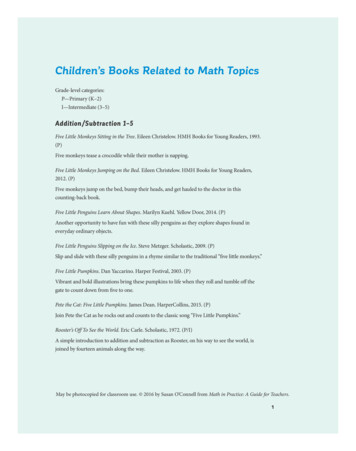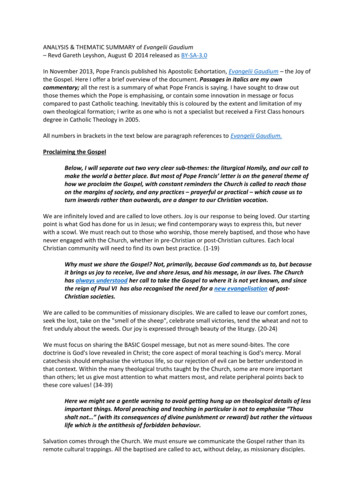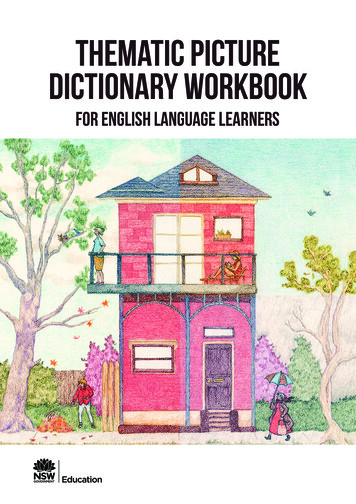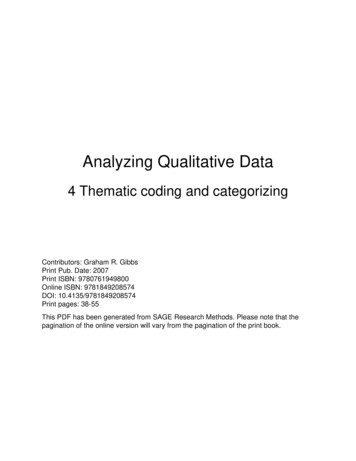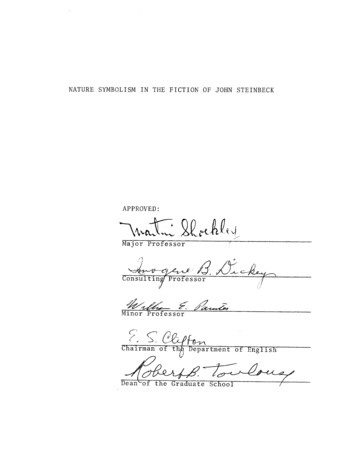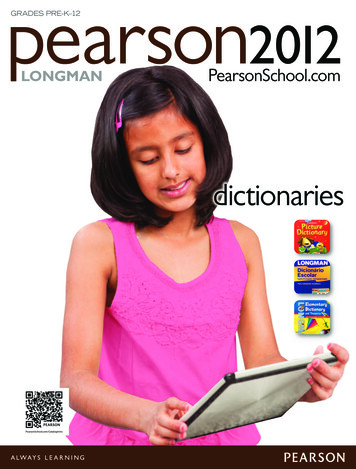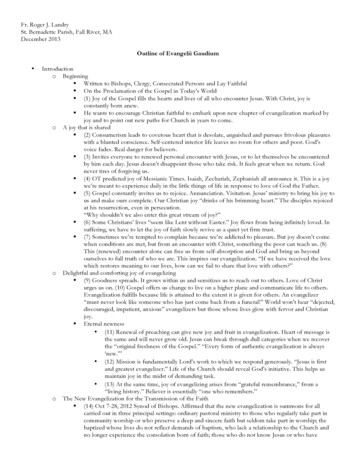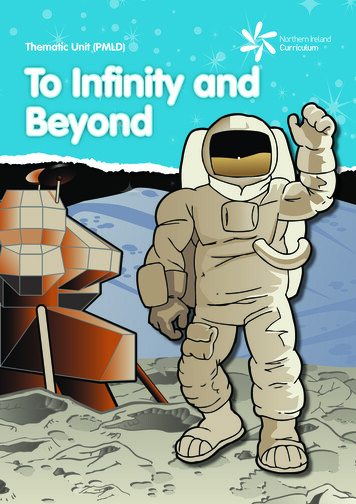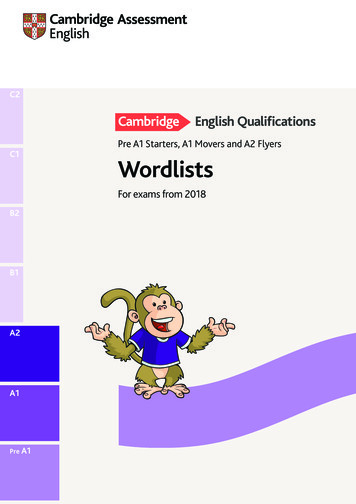
Transcription
Pumpkins, Pumpkins, PumpkinsA Thematic UnitByAnson H. BakerDeborah CooleyKristin PingelJune 26, 2002
TABLE OF CONTENTSThis interdisciplinary project is based on the theme of PUMPKINS. It is intended for usein a second grade classroom, but could easily be adapted for use in another, higher orlower.UNIT 1: LITERATURE, READING, AND WRITING Lesson 1: Pumpkin Pumpkin IntroductionStudents will be introduced to the story Pumpkin Pumpkin, make predicitionsand do a paired sequencing activity. Lesson 2: Pumpkin Pumpkin SequencingStudents will read Pumpkin Pumpkin, tell the story in their own words, andplay a pumpkin pairing game. Lesson 3: Pumpkin Pumpkin Vocab & WritingStudents will extend their vocabulary, comprehension, and language use andwrite a story using the vocabulary learned. Lesson 4: Pumpkin Songs and PoemsStudents will be introduced to songs and poems about pumpkins and willreview emotions from a previous lesson.UNIT 2: MATH Lesson 1: Pumpkin Base TenStudents will work with pumpkin seeds to practice and gain proficiency inusing the ones and tens groups. Lesson 2: How Many Pumpkins Tall Are You?Students will measure each other's height using pumpkins as non-standardunits of measurement. Lesson 3: Pumpkin Rolling ContestStudents will estimate through a "pumpkin rolling contest" and compareestimates to measurements.2
Lesson 4: Bar GraphStudents will analyze a bar graph to determine which groups had the closestand farthest estimations.UNIT 3: SCIENCE, SOCIAL STUDIES, AND FIELD TRIP Lesson 1: Pumpkin GrowthStudents will get the opportunity to read and evaluate books and gaininformation about the pumpkin growth cycle. Lesson 2: Field Trip Prep. - Internet ActivityStudents will prepare for a field trip by using the Internet to evaluate websitesand create maps to pumpkin farms. Lesson 3: Field Trip to a Pumpkin FarmStudents will go to a pumpkin farm to observe pumpkins, then compare andcontrast pumpkins on a Venn diagram. Lesson 4: Plant Pumpkins, See What HappensStudents will put into practice their knowledge of pumpkin growth, planting,caring for, and observing their own pumpkin.PUMPKIN EXTRAS: Additional games, songs, and activities to be used inconjunction with the three pumpkin units.3
Lesson 1Pumpkin Pumpkin - IntroductionOBJECTIVE:The students will listen to the story, participate in the class discussion, and respondappropriately to questions asked by the teacher.STANDARDS:Goal 2 Standard 1: Follow oral directionsExpressing likes and dislikesParticipating in full class discussionsGoal 2 Standard 2: Hypothesizing and predictingGoal 2 Standard 3: Applying basic reading comprehension skills such as skimming,scanning, previewing, and reviewing textMATERIALS:The big book Pumpkin Pumpkin by Jeanne TitheringtonStand, chart paper, and markerPumpkin Sequence cardsStrips of white paper 4 inches high and 32 inches longPROCEDURE: Settle children on the floor around you and invite them to look at the front cover.Read the title and give the children time to talk about what they see.Ask the children to tell who they think the boy is and why he is sitting on thepumpkin.Turn the pages slowly, without reading it, to give the children time to look at theillustrations.Ask students to tell you some of the things they see and what they think the bookmight be about. Record on the chart paper at least one prediction from each child,adding initials for identification.Read the story to the end without pausing.Now return to the comments recorded earlier. Have each child read his along withyou.Encourage children to respond to the story. Ask them if they liked it, what they likedbest about it, and which illustration was their favorite.Recap the story with the group. Ask what Jamie did with the seed, what happens nextand so on. Draw a rebus on the chart paper to show the sequence of the pumpkinplant's growth.4
Divide the group into pairs and pass out the sheets of pumpkin sequence cards andplain strips of white paper. Have students work together to cut and paste the cardsonto the white strips in the correct order.ASSESSMENT:Students responses to questions about the story.Successful completion of the sequence activity.5
Lesson 1Rebus6
7
8
Lesson 2Pumpkin Pumpkin SequencingOBJECTIVE:Students will reread the story Pumpkin Pumpkin by Jeanne Titherington and beencouraged to read it on their own. They will be encouraged to retell the story in theirown words and use the correct sequence. Students will look for p words. Students willparticipate in a card game with peers.STANDARDS:Goal 1 Standard 2: Participating in popular cultureGoal 2 Standard 2: Retelling informationGoal 3 Standard 1: Using the appropriate degree of formality with different audiencesand settings.MATERIALS:Pumpkin Pumpkin big book and Pumpkin Pumpkin small books, one for each studentsChart stand, paper and markerPumpkin Pairs for card gameSentence stripsPROCEDURE: Reread story through a second time using your hand as a pointer to underline thewords as you read them.Give children a chance to respond to the story on a personal level.Read it again and invite students to read along with you.Distribute individual small books and ask for volunteers to read each page.Reinforce the sequence by using the rebus from lesson 1. Remind the children thatthis helps them remember what happened first, second, third and so on. Tell the storyout of order and see if students can tell you what is wrong. Afterward ask children toretell the story in their own words.Give students strips of paper with the sentences from the story written on them. Onesentence per strip. Divide the class into groups or 2 or 3 and have them put thesentences into the correct sequence.Print the words Pumpkin Pumpkin on chart paper. Challenge the students to find theP words in the story. Make a list. Then ask for other words that begin with p. Addthese to the list. Read all the p words and have volunteers underline the initial p ineach.Divide the class into pairs and play the card game Pumpkin Pairs. It is just likeConcentration. Directions and patterns for the cards follow this lesson.9
Discuss the faces on the pumpkin cards. See if students can identify the emotionsdepicted on the faces of the pumpkins.ASSESSMENT:Teacher will note ability of students to retell the story.Teacher will note if each group is able to put the story strips into the correct sequenceTeacher will observe student participation in card game by walking around the room andlistening to the verbal exchanges.10
11
12
13
Lesson 3Pumpkin Pumpkin - Vocabulary and WritingOBJECTIVES:To extend vocabulary comprehension and language use through various activities usingthe book Pumpkin Pumpkin. To write a story using the vocabulary learned to date.STANDARDS:Goal 1 Standard 3: Testing hypotheses about languageExploring alternative ways of saying thingsGoal 2 Standard 3: Using context to construct meaningGoal 3 Standard 2: Recognizing and adjusting behavior in response to nonverbal cuesMATERIALS:Big book Pumpkin PumpkinStand, chart paper, and markersPumpkin shape writing bookletsPROCEDURE: Write the following sentence on chart paper: Jamie planted a pumpkin seed. Use adifferent color marker when writing Jamie and pumpkin. Invite children to tell whatkind of seed they would like to plant. Write each child's response under the modelsentence (See example following lesson). After each child has responded, have thestudents read the sentences. Ask them which words in the sentence are the same andwhich are different.Write the following sentence on chart paper: Jamie scooped out the pumpkin pulp.Invite a child to read the sentence. As the student reads it, pantomime the action forscooped. Tell the children that scooped is an action word and tells what Jamie did.Use the text to find other action words. Have students read them and pantomimethem. Ask for other action words to be pantomimed. See if the students can guessthem. Then add them to the list.Turn the pages of the book so that the children can see the illustrations. Ask them toname the animals they see. Print the animals' names on chart paper. Tell the childrenyou will tell them a riddle about each animal and they must guess which one it is.See the examples following the lesson.Remind the children what action words are. Invite them to choose one of the animalsfrom the story and pantomime how the animal moves.Now distribute the pumpkin shape books (See example following lesson). Do a storyweb then have the students write a story about pumpkins using the learnedvocabulary. Provide a word bank for those who need it.14
ASSESSMENT:Students' responses to teacher questions would be an indication of their depth ofunderstanding.Date and keep the story as part of portfolio that can be compared to later work.15
16
Lesson 4Pumpkin Songs and PoemsOBJECTIVES:Students will be introduced to some songs and poems about pumpkins. The main songHere's A Pumpkin will eventually be learned by the class. The accompanying flannelboard activity will serve as a review for shapes and Boehm concepts such as "on top of."STANDARDS:Goal 1 Standard 2: Expressing personal feelingsReading or participating in a favorite activityGoal 2 Standard 3: Selecting different media to help understand languageListening to and imitating how others use EnglishMATERIALS:Flannel boardShapes listed on the Here's a Pumpkin pageWords to songs and poems written on chart paperStand and chart paperTwo large paper pumpkinsTwo sets of facial features for a Jack-O-LanternStrawsPROCEDURE: Seat the children in a semicircle around you and the materials. Have students becomefamiliar with the words to Here's A Pumpkin. Read it through going over anyvocabulary that might need to be explained. Ask for questions.Have students read it through with you. Do it more than one time if they seem to behaving difficulties.Introduce the tune. Sing it first then have the students sing with you.Show the class the orange pumpkin. Talk about it's color and shape as well as theother felt pieces to the song. Distribute them to various students and have them putthem on the board as the song is sung (Give every student the opportunity toparticipate).Read and discuss the poems. Ask students if they have a favorite they would like tolearn.Divide the class into two teams and play Jack-O-Lantern Relay Race.17
ASSESSMENT:Observation of students listening skills as they place the parts on the Jack-O-Lanternwhile the song is sung.Observation of reading skills as students read the poems aloud to the class.18
19
Objective:Students will measure each others’ height using pumpkins as units of measurement.National Standards:Goal 1 Standard 3: selecting different media to help understand languagesharing and requesting informationusing non-verbal communication in social interactionGoal 2 Standard 1: participate in full class, group, and pair discussionask and answer questionsrequest information and assistancenegotiating and managing interaction to accomplish tasksGoal 2 Standard 2: representing information visuallyinterpreting information presented visuallyMaterials:Mini post-it notes (1/student), 12” rulers (1/student), 1 large pumpkin (about 10” tall),“Measure Your Partner” worksheets, marker board & markers, pencilsProcedure:Have students bring their 12” rulers, post-it notes, and their worksheet to the front of theroom and form a group on the carpet around you. Show students a large pumpkin. Askstudents what time of year we usually see a lot of pumpkins and why. (PossibleAnswers: Fall, because that is when they are harvested.) Then ask them all of thedifferent things people can do with a pumpkin. (Possible Answers: carve it forHalloween, make pumpkin pie or pumpkin bread, etc.) Tell students that we are going tohave some fun using a pumpkin to measure our height. They need to fill in the blanks onthe worksheet as the lesson goes along. It would be a good idea to read the items aloudon the worksheet before getting started. Call on a student to measure the pumpkin withhis or her 12” ruler. Write how many inches tall the pumpkin is on the board. They areto put a post-it note on their ruler to mark how many inches tall the pumpkin is. Tellstudents that the pumpkin is one unit. Ask students how many inches are in one unit. Ifthe pumpkin is 10” tall, confirm that there are 10” in a unit. They need to figure out howmany units, or pumpkins tall their partner is. Record a couple of examples on the boardafter students are finished measuring. Ask students how many inches equals two units.Then have students tell how many inches tall their partner is, keeping in mind that thereare 10” in one unit. They are to record their findings.Evaluation:Collect students’ “Measure Your Partner” worksheets to make sure everyone was on theright track throughout the lesson.20
Measure Your PartnerName:1.) How many units is the pumpkin? unit(s)2.) What is the length of the pumpkin (in inches)? inches3.) How many inches are in one unit? inches per unit4.) How many units, or pumpkins, tall is your partner? units5.) How many inches tall is your partner? inches21
Objective:Students will understand estimation through playing an interactive game in smallcooperative groups.National Standards:Goal 1 Standard 1: sharing and requesting informationusing non-verbal communication in social interactionGoal 2 Standard 1: participate in full class, group, and pair discussionnegotiating and managing interaction to accomplish tasksGoal 2 Standard 2: comparing and contrasting informationhypothesizing and predictingunderstanding and producing technical vocabularyGoal 2 Standard 3: actively connecting new information to info previously learnedMaterials:pencils, worksheet, 4 or 5 large pumpkins (approx. 10” tall), string, masking tape, 12”rulersProcedure:Ask students what it means to make a guess. Tell them that they will be playing a gamewhere they have to guess, or estimate. Write the word “estimate” on the board and havestudents repeat it aloud. Tell them that they are going to have a pumpkin rolling contestwhere we will estimate the distance the pumpkin will go with one big push. Demonstratethe action of rolling a big pumpkin with one big push. Command students to get intogroups of four or five. Each group gets one pumpkin. Using prior knowledge from theprevious math lesson, have students measure the length of the their pumpkin with theirruler and record it on their worksheet. Also, have students cut a piece of string the lengthof their pumpkin. Each student in each group gets to take a turn pushing the pumpkinwith one big push to get a basic idea of how far the pumpkin might roll. Students are todiscuss together, or “estimate” how many units, or strings lengths, their pumpkin willroll. They are then to figure how many inches that is, then record their estimates on theirworksheets. Have a student put a piece of masking tape where the pumpkin starts. Haveanother student push the pumpkin on your signal. Have another student mark with tapewhere the pumpkin stopped rolling. Students will then take their string to measure fromone piece of tape to the next to see how many units, or string lengths their pumpkinrolled. They are to then have a discussion with each other to figure out how far it rolledin inches and record their findings. Explain that they need to see how far or close theirguess, or estimation, was to the actual distance the pumpkin rolled. Ask students howthey can figure that out. Reiterate that they have to subtract the small number from thebig number to find the difference, and then record their difference on their worksheets.Then, have a student from each group to write their difference on the board. Ask theclass what the smaller numbers on the board mean. (Answer: Their estimations wereclose to the actual distance the pumpkin rolled.) Ask students what the bigger numbersmean. (Answer: Bigger numbers mean that their estimations were further away from theactual distance the pumpkin rolled.) With all of the differences written on the board, askstudents to figure out which team had the closest estimation.22
Evaluation:Collect “Pumpkin Estimation Game” worksheets from the students to make sureeveryone was on the right track. The students in the group who had the closest estimateeach get to go home with a big pumpkin as a prize for winning the game.23
Pumpkin Estimation GameName:1.) What is the length of your pumpkin in inches? inches2.) 1 pumpkin unit(s)3.) 1 unit inches4.) Estimate of units you think your pumpkin will roll: units5.) Estimate of inches you think your pumpkin will roll: inches6.) Actual distance your pumpkin rolled in units: unit(s)7.) Actual distance your pumpkin rolled in inches: inches8.) Subtract the distance your pumpkin rolled from your estimation, or yourestimation from the distance your pumpkin rolled (depending on which number isbigger). Remember to subtract the small number from the big number, and useinches.Answer: inchesDraw a circle around the underlined word choice you think is correct.9.) A high number (like 21 or higher) means your estimate was: close to or far from the distance your pumpkin rolled.10.) A low number (like 20 or lower) means your estimate was: close to or far from the distance your pumpkin rolled.24
Objective:Students will analyze a bar graph to determine which group had the closest and furthestestimations from the “Pumpkin Estimation Game” they played in the previous lesson.National Standards:Goal 1 Standard 3: selecting different media to help understand languageGoal 1 Standard 1: sharing and requesting informationusing non-verbal communication in social interactionGoal 2 Standard 2: comparing and contrasting informationselecting, connecting, and explaining informationrepresenting info visually and interpreting info presented visuallyGoal 2 Standard 3: actively connecting new information to info previously learnedMaterials:“Pumpkin Estimation Game” worksheets from previous lesson, white board & differentcolored markers to use for graph, pencils, new “Bar Graph” worksheetsProcedure:Hand the “Pumpkin Estimation Game” worksheets back to the students as well as havethem get in to the same groups they were in during the previous game activity. Write theword “graph” on the board and ask students what they know about graphs. Explain that agraph is another way that we could have seen who won the pumpkin estimation contest inthe previous lesson. Tell them that a graph is basically a picture representing theinformation. Inform students that instead of just listing numbers on the board to see whowon, we could draw a picture to show who won. Have students report the difference (ininches) between their estimation and the distance their pumpkin actually rolled. Recordtheir differences on the board. Draw a graph like the following, and label it “Bar Graph.”25
Assign a number (1, 2, 3, & 4) to each group. Tell each group that “G1” equals “Group1.” “G2” equals “Group 2,” and etc. Ask students what they think the left side of the bargraph means. (Answer: However many inches students’ estimates were away from theactual distance the pumpkin rolled.) Ask students what the bottom of the graphrepresents. (Answer: Each of the different groups.) Ask “G1” how far they were fromtheir estimation and draw a bar up to the proper height on the graph. Do the same for“G2.” For the last two groups, see if a student is willing to volunteer to draw the bars upto the proper height. Ask students what the taller bars on the graph mean. (Answer:Estimation furthest from the distance the pumpkin was rolled.) Ask students what theshorter bars on the graph mean. (Estimation closest to the distance the pumpkin wasrolled.) Finally, ask the students why they think this particular graph is called a bargraph. (Answer: Information is represented by bars.)Evaluation:Hand out the “Reading a Bar Graph” worksheets for the students to work on with apartner. When the students are finished, collect the worksheets to see what the studentsunderstood and what they need to work on.26
Reading a Bar GraphName:1.) What kind of graph did we discuss today? graph2.) What do the numbers going up the left side represent?.3.) What does “G2” represent on the graph? . “G4”?4.) What do the shorter bars mean?.5.) What do the taller bars mean?.6.) Which group had the closest estimate?7.) Which group had the furthest estimate?27
Objective:Students will understand numbers, ways of representing numbers, relationships amongnumbers, and number systems using pumpkin seeds.National Standards:Goal 1 Standard 3: selecting different media to help understand languageGoal 1 Standard 1: sharing and requesting informationusing non-verbal communication in social interactionGoal 2 Standard 2: reflecting, connecting, and explaining informationrepresenting information visuallyMaterials:50 pumpkin seeds, 4 tiny Dixie paper cups, “Number Units” worksheet, pencils, markerboard & markersProcedure:Have students form a group in the front of the room. Show students a handful ofpumpkin seeds and ask students what they are and what food they are from. Tell themthey are going to learn how to add and subtract number more quickly by using pumpkinseeds. Put ten pumpkin seeds in each of four Dixie cups. Have four different studentsrecount the seeds in each cup, reporting results to the class. Have a separate pile of 10pumpkin seed outside of the cups. Reiterate to the class that there are 10 seed in each ofthe 4 cups. Tell students that each cup is one unit. Then ask them how many seeds are ina unit. (Answer: 10 seeds per unit) Ask them how many units 2 cups equals. (Answer:2 units) Then have them tell how many seeds 2 units equals. Ask students how wewould show 1 unit plus 5 seeds. (Answer: Draw a cup with the number 10 inside. Drawfive seeds sitting outside of the cup.) Ask how many seeds are in 1 unit plus 5 seeds.Ask a volunteer to demonstrate, on the board, 23 seeds. (Answer: Draw two cups eachwith a 10 written inside. Draw 3 seeds standing alone outside of the cups.) Then, showthe students the same answer using the actual Dixie cups with seeds, along with the seedsthat stand along outside of the cups. Ask another volunteer to demonstrate, on the board,47 seeds. (Answer: Draw 4 cups each with the number 10 inside. Draw 7 separate seedsstanding alone outside of the cups.) Then, show the students the same answer using theactual Dixie cups with the seeds along with the extra seeds by the cups.Evaluation:Hand out the “Number Units” worksheet to the students. Read aloud each of thequestions while students read along. Ask if there are any questions. Allow students towork in partners if they choose to. Encourage students to come up to the front of theroom to use the Dixie cups and seeds if they need to. Collect worksheets when studentsare finished to see if students are catching on.28
Number UnitsName:1.) How many seeds are in one unit? seeds2.) How many seeds all together in 2 units plus 7 seeds? seeds3.) How many units are in the number 30? units4.) How many units and seeds are in the number 22? units and seeds5.) Draw a picture of 3 units plus 9 seeds in the space below.29
Pumpkin GrowthObjectives: Students will: Learn the growth cycle of pumpkins and plants in general. Create a visual representation of the growth cycle of a pumpkin. Work in cooperative groups to complete a task.Standards: Grades Pre K-3 Goal 1, Standard 1: sharing and requesting information, expressing ideas,engaging in conversation, conducting transactions. Goal 1, Standard 3: focusing attention selectively, seeking support and feedbackfrom others, practicing new language. Goal 2, Standard 1: following oral and written directions, participating in pairdiscussions, asking and answering questions, requesting information andassistance, negotiating and managing interaction to accomplish tasks, expressinglikes and dislikes. Goal 2, Standard 2: comparing and contrasting information, listening to,speaking, reading, and writing about subject matter information, gatheringinformation, retelling information, selecting, connecting and explaininginformation, responding to the work of peers and others. Goal 2, Standard 3: applying basic reading comprehension skills (skimming,scanning, previewing, and reviewing text), taking notes to record importantinformation, recognizing the need for and seeking the assistance appropriatelyfrom others.Materials: Pumpkin Books (wide variety, not all about pumpkin growth, not all non-fictionor relevant). Pumpkin Book Sheet (for taking notes about pumpkin growth). Art Materials (for production of pumpkin growth cycle representations)Procedure:This lesson is taking place under the assumption that the students have already learnedbasic note taking skills.Activity #1: Get you own info Students will be put into groups of four. These groups will be given a variety ofbooks about pumpkins (fiction and non-fiction). The groups will need to look through the books for information about pumpkingrowth. They will need to discriminate between useful and non-useful books. The group members will record their pumpkin growth facts on the Pumpkin BookSheet. For each book that they read, the students will use a new Pumpkin BookSheet. After given enough time to collect an adequate amount of information about plantgrowth, the students will do a round robin exercise, telling the facts that theylearned about pumpkin growth, using their Pumpkin Book Sheets.30
Then, the group will need to remove the books that they found to be non-usefuland give one reason, to the group, why each book is not useful to the exercise.Activity #2: I’ll give you some info Discuss, with the students, what they learned about pumpkin growth. Recordtheir data on a chart. Read the book, Growing a Pumpkin by Adrienne Sharp. Discuss the book withthe students and compare their data to the book. Discuss growth cycle of apumpkin, and label the different stages on a chart paper, to be referred to later bythe groups. The groups will then go back and will need to describe what each of the stages ofa pumpkin’s growth cycle is like. They may go back to their books that wereuseful before to help them. They will need to construct a diagram of the differentstages of pumpkin growth, including a labeled picture with a description of thestage.Assessment: Students will be assessed informally about their participation, effort, group andsocial interactions, as well as completion of the tasks. Groups will be assessed on the completeness of their diagrams of pumpkin growthstages.31
Pumpkin Book SheetName of the book:Pumpkin Growth Facts:If this book was not useful, tell why.32
Field Trip Preparation-Internet ActivityObjectives: Students will: Practice using search engines to locate information. Locate places on maps and create maps using Internet sources. Evaluate information and make a judgment about quality of information. Work effectively with a partner. Evaluate and review their own performance, as well as evaluate and review theactivities.Standards: Grades Pre K-3 Goal 1, Standard 1: sharing and requesting information, expressing ideas,engaging in conversation, conducting transactions. Goal 1, Standard 3: focusing attention selectively, seeking support and feedbackfrom others, practicing new language. Goal 2, Standard 1: following oral and written directions, participating in pairdiscussions, asking and answering questions, requesting information andassistance, negotiating and managing interaction to accomplish tasks, expressinglikes and dislikes. Goal 2, Standard 2: comparing and contrasting information, persuading arguing,negotiating, evaluating, and justifying, listening to, speaking, reading, and writingabout subject matter information, gathering information, retelling information,selecting, connecting and explaining information, responding to the work of peersand others. Goal 2, Standard 3: applying basic reading comprehension skills (skimming,scanning, previewing, and reviewing text), taking notes to record importantinformation, recognizing the need for and seeking the assistance appropriatelyfrom others.Materials: Computer Lab (enough computers with internet access for the entire class to workin pairs). Internet Record Sheets (for taking notes on internet sources). Large Map of the U.S. (for plotting points). Activity Review Sheet.Procedure:This lesson is taking place under the assumption that the students have already learnedbasic internet searching skills, that they have learned some map skills and beenfamiliarized with mapmaking internet sites, and that they have already undertaken somestudy of pumpkins.Activity #1: Location, Location, Location33
The students will be given the task of finding a good place to take a field trip sothat they could learn about pumpkins and pumpkin farming first hand. They aregoing to need to locate, on the Internet, four sites that have information about apumpkin farm or pumpkin patch that welcomes class trips as visitors.For the purpose of the exercise, money is not an object, so the cost of the trip willnot matter. Location of the pumpkin farm is also not an issue. The focus of theirsearch should be to find the four best pumpkin farms that they can.They may find more than four websites, so they will need to be selective, pickingthe four best.Students will be put into partner groups. Each group will be provided InternetRecord Sheets and one computer with Internet access. They will need to be givenample time to locate, record, and justify their choices about the four best pumpkinfarms that they could find. This activity does not need to be limited to just oneday.Once the students have
in a second grade classroom, but could easily be adapted for use in another, higher or lower. UNIT 1: LITERATURE, READING, AND WRITING . SOCIAL STUDIES, AND FIELD TRIP Lesson 1: Pumpkin Growth- Students will get the opportunity to read and evaluate books and gain information about the pumpkin growth cycle. Lesson 2: Field Trip Prep .
